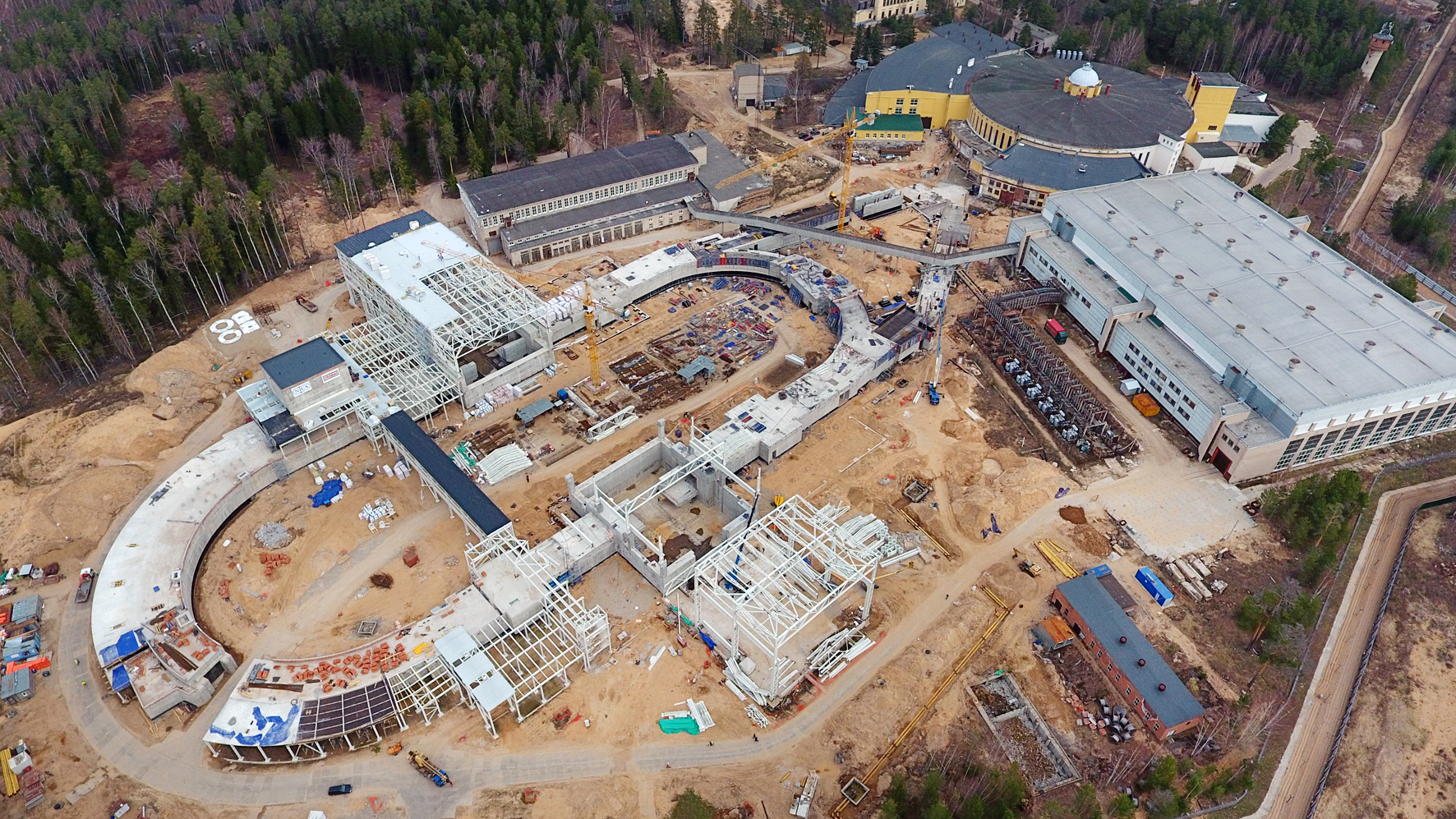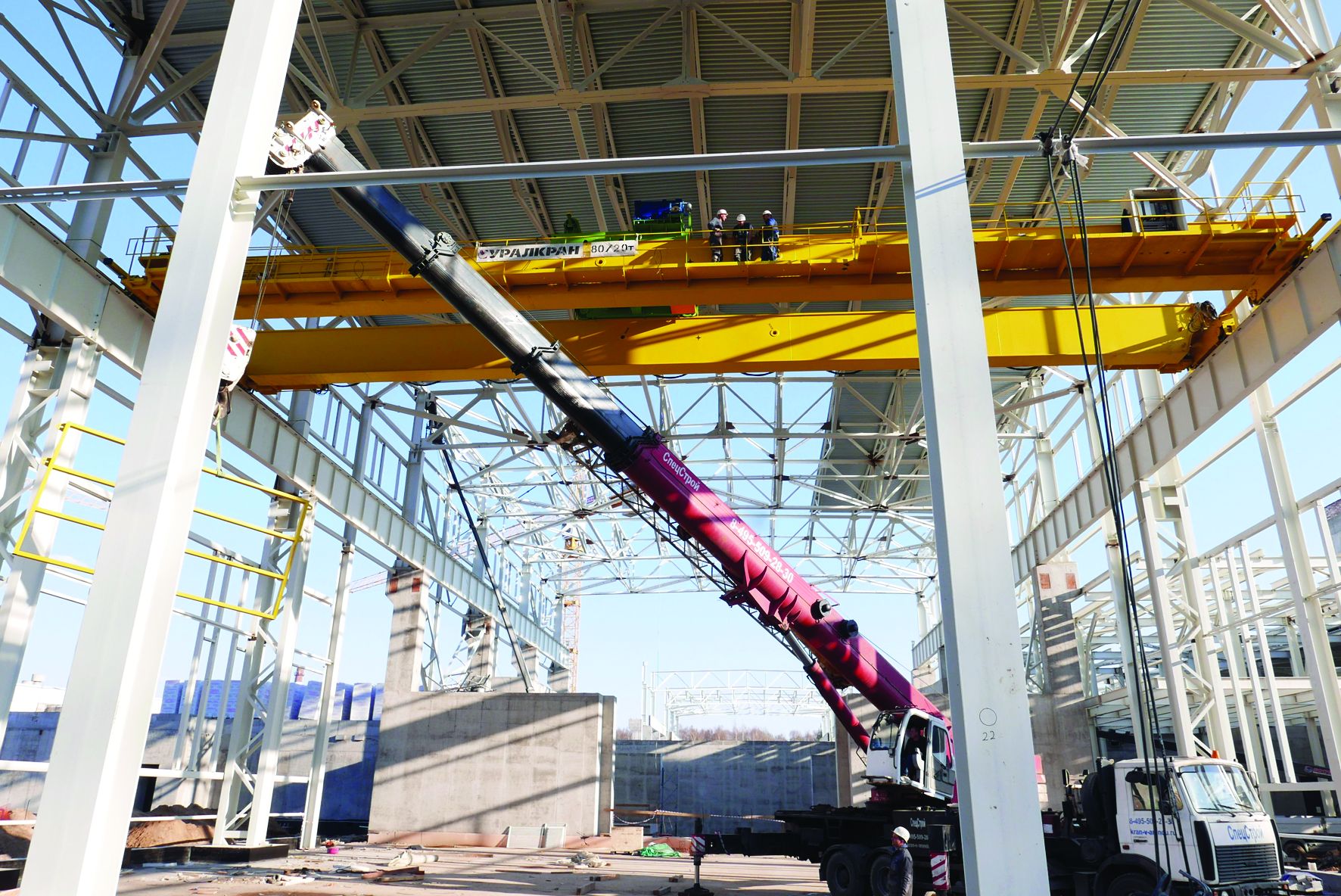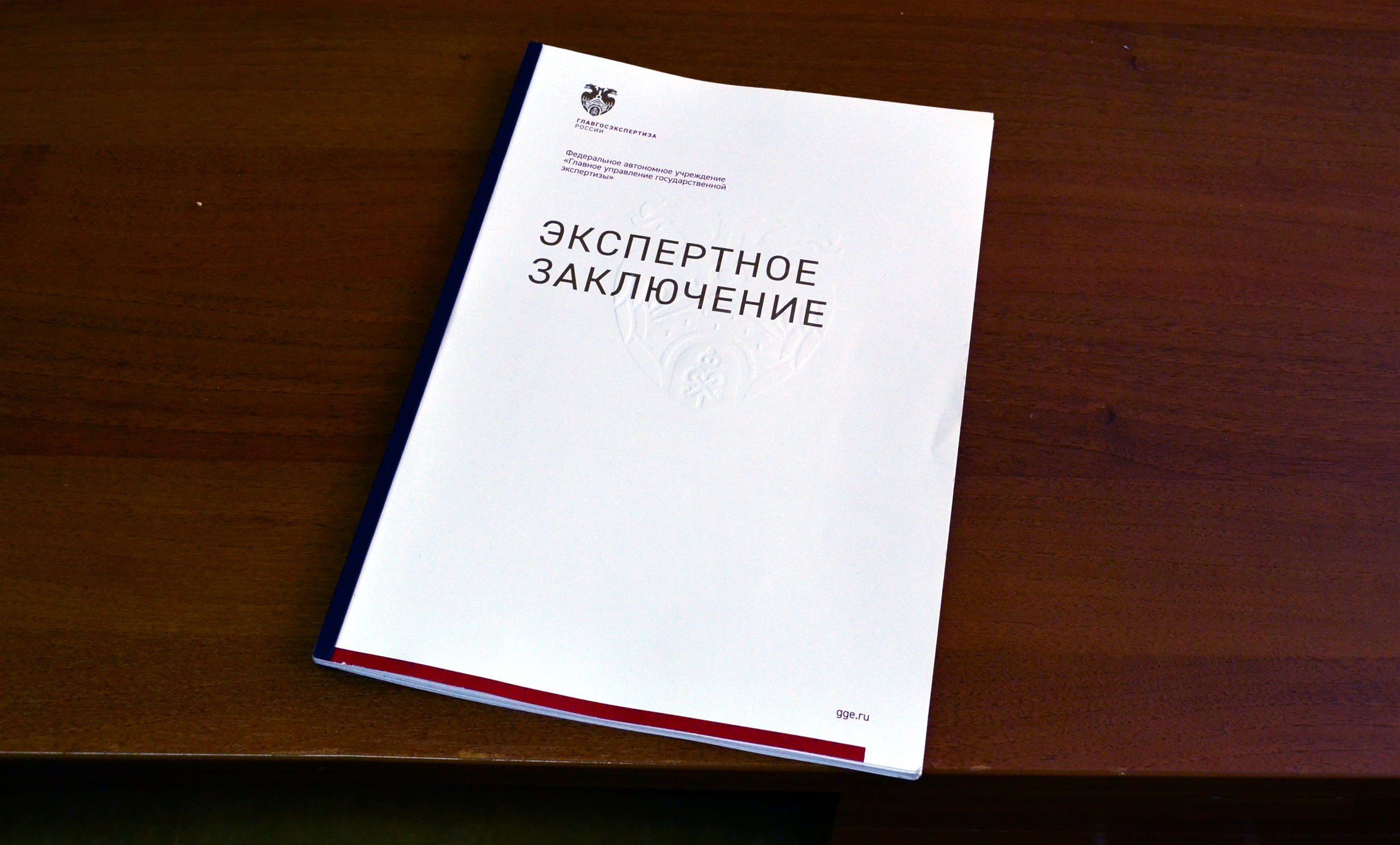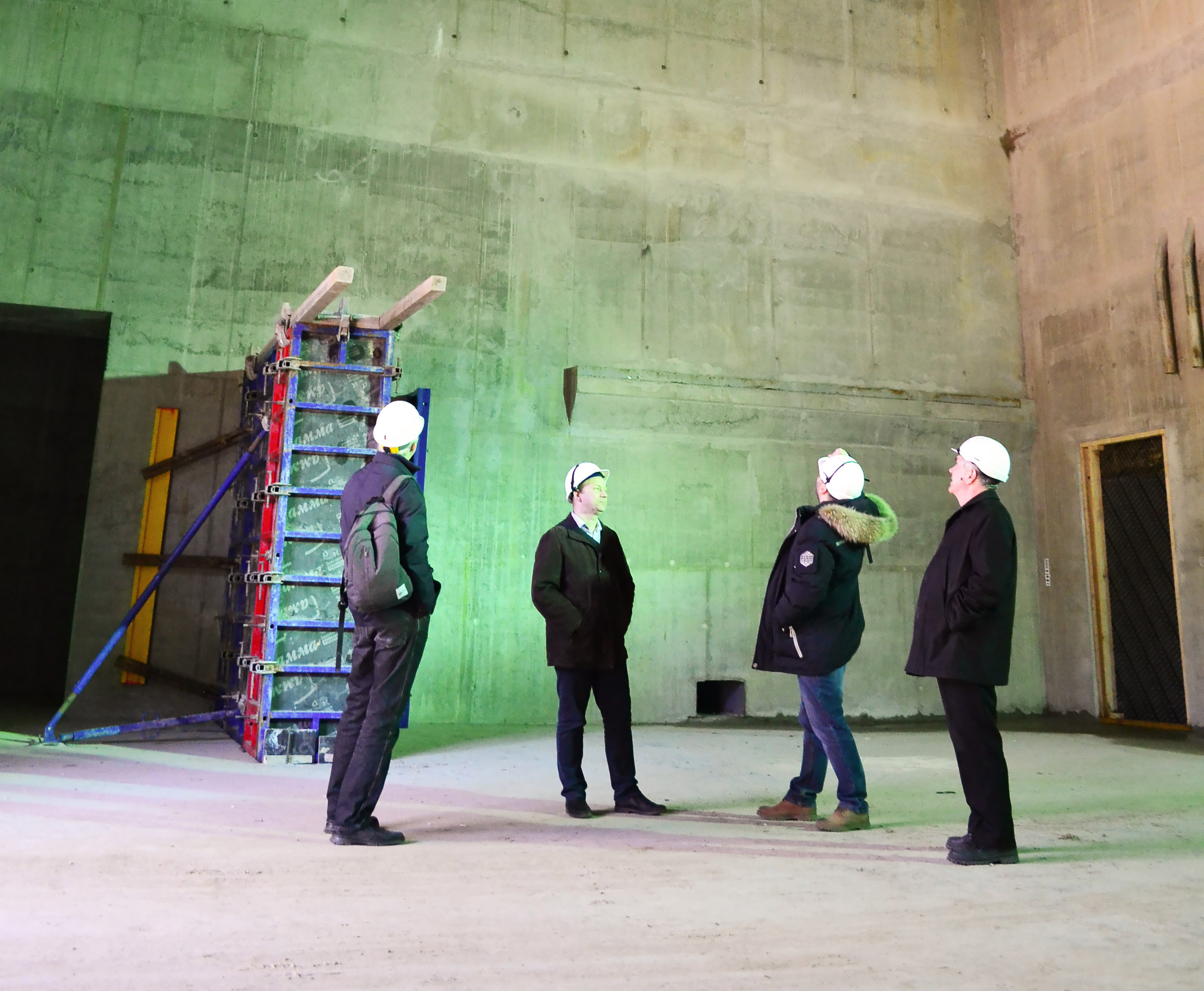Projects of the XXI century
News, 25 April 2019
The report by the JINR Weekly Newspaper
A regular visit of the journalist to the NICA construction site this time was marked with a significant event: a favourable conclusion was obtained from the state examination for the revised design documentation and results of the engineering surveys of the “NICA” object. That is why at first, representatives of the project organization Chief Engineer of the CJSC “Cometa” Nikolay Delov and Chief Engineer of the project Vasiliy Kozhanov said what work preceded this event. After that, Deputy Chief Engineer of JINR Andrey Dudarev, Deputy Head of the Department of Capital Projects Yuri Balandin, Engineering System Project Manager Musabeg Magomedov (“Strabag” public company) provided a traditional “excursion” around the object.
Previous report by the JINR Weekly Newspaper, November 2018
 Photo taken from a quadcopter by Konstantin Shevchenko
Photo taken from a quadcopter by Konstantin Shevchenko
Examination is like going through fire and water for many times
NICA is classified as an object of using atomic energy. The design documentation of such an object is subject to being examined. To understand how and why it is needed, the first question was asked to Nikolay Delov who has been working in JINR since 1984: How everything started?
“Our company is the general designer of this object. The main project branches are implemented by our specialists; for carrying out some of them, we also subcontract specialized project organizations.
In 2008, JINR invited us to discuss the possibility of organization of design work on the creation of a new accelerating complex in the Institute. At that time, the customer did not have a clear idea. There was an offer to place this accelerator in the already existing building 205. The planned length of the accelerator was about 200 metres at that time. Gradually, with the development of the concept of the complex, physicists came to a decision to construct the complex with channels of the beam output from the Nuclotron’s building. We worked out the design documentation, and in 2013, we got a favourable conclusion of the state examination.”
“It is known that the project was amended and remade after the beginning of the construction. What exactly has changed? “
“The weight of the MPD detector changed: it increased up to 1,300 tons. It was decided to construct the pavilion of the SPD detector for the same load. A range of premises was added, and thus the construction area increased. That is why in 2018, it was decided to amend the design documentation and pass the state examination once again. This year, it was done also at the first attempt. It is a significant achievement as far as our experience shows that to get a favourable conclusion one needs to go through fire and water for many times. On one hand, you should show that you are right. On the other hand, you should fulfil some demands in several aspects. For example, it was necessary to check the impact of the new construction, the foundation pit of the MPD pavilion, on the corner of the building #1A. The Gersevanov Research Institute of Bases and Underground Structures (NIIOSP) estimated possible molded draft. It accounted for 1 millimetre while the standard allows it to be up to 30 millimetres.”
 Nikolay Delov and Vasily Kozhanov
Nikolay Delov and Vasily Kozhanov
“What is the procedure of the examination?”
“I would divide it into two parts,” Vasiliy Kozhanov says. “The first part is submitting documents. It took a lot of time, from September to December of the past year, as far as questions concerning the completeness of documentation were being solved. Before the New Year, JINR entered into a contract on undergoing the examination, and thus the second stage started – work of experts.”
“Nikolay Ivanovich, how does this important stage undergo?”
“Having obtained documentation, the leading expert spreads examination according to the branches. Experts of each branch write their remarks. After that, we are supposed to consider and comment on all the remarks in 10 days. The term is short, especially for such complicated projects as the NICA collider. Not everything depends on us; sometimes we have to address to the city administration, power supply companies, and regional organizations. I would like to mention that the customer, the Joint Institute, showed an excellent organization and a quick response. All issues, which were supposed to be solved jointly with the customer, were quickly overcome. One one day there was a question, the next day we got an answer. We worked as one team. Such a result was obtained thanks to this joint work. According to our previous experience, not all customers and not always are so friendly and so interested in passing the examination.”
“How many remarks there were? Was it possible to count them?”
“There were 50 pages,” – V. Kozhanov says. “There even were no comments to some branches. There were no comments regarding energy efficiency, for example, or operation safety. There was a question about the lifting of the transport equipment. The expert in construction and building inspection wrote 8 pages of comments. Some questions were interrelated; if one question is solved, another is also overcome. Some issues demanded additional extensive measurements and calculations. For example, in 2016, such standard as snow load changed; and we had to recount engineering structures. As a result, on the last days before submitting a package of comments and documentation, our specialists worked nearly all days and nights.”
“Vasiliy Alexandrovich, such objects have not been constructed in Russia for 25 years. So what were the main difficulties when the design work was carried out?”
“The main difficulty is that equipment of the collider is not a typical one. It has not been yet fully worked out. While we were developing the project at large, everything was clear. When we started to prepare particular documentation, some questions emerged: where and what should be led, how to fix it, what support structures are necessary for structural elements, and etc. If we waited for the final variant of the concept, then there would be still the forest. Another issue is complicated geological conditions, tough requirements for equipment stability. That is why long piles were used, and it was difficult to drive them into the ground to the designed level. We had to spend a lot of time to select technologies, ways to bed them. Of course, we cannot say that new scientific ideas, which caused changes in the project, hindered, but they definitely did not help to advance. We understand it, but in terms of the process of designing, we had to stop, return, complete and remake something.”
“Moreover, equipment is unique,” – N. Delov adds. “It should be worked out in such a way as to deliver it, assemble and, as we call it, “bind” it, i.t. to supply energy, heating, communications, and etc. until the end of construction work. It is not a simple building; it is a physical instrument at which physicists will work for several decades. The project is not difficult in terms of construction. It is complicated in terms of the technologies used in equipment and the process that will take place here.”
***
The conclusion of the examination consists of not only a couple of pages with stamps. It is a stitched massive book in which the experts’ agreement on all branches is documented. Such a heavy passport for NICA was obtained at the beginning of April. Only those who carried out surveys, prepared references, measurements, technical drawings, gave access and agreements know how much human efforts and energy are involved in these pages. The JINR Weekly Newspaper joins to congratulatory addresses of the JINR Directorate and leaders of the project. We wish the team of developers further success!
One of the reasons for being examined once again was the cable tray system that, according to the design of 2013, should have been dismantled.
At the cross section of knowledge, at the cross section of times
Every time we are at the construction site, we recall how the landscape has changed since the last visit. Pit and excavation work, trenches, pipelines, drainage… The term “construction footprint” was used often; people left their cars outside the fence and went on foot. Pits, concrete, foundation, roads… counters of the MPD pavilion and the collider’s ring became obvious. The building road was constructed, The tunnel and building – systems of electronic cooling and detectors – were erected; concrete walls started to be covered with metal structures. Now, it is a labyrinth with new walkways and galleries. Metal structures are now being roofed over; façade builders are about to start their work. It will not take much time for work to move inside the premises.
 Elevated path for operating personnel from one side of the ring to another that was not been included in the design project of 2013
Elevated path for operating personnel from one side of the ring to another that was not been included in the design project of 2013
“So, what has changed among those things that cannot be seen at the site for half a year?”
“We advanced to work on the existing buildings #1 and #205,” – Engineering System Project Manager Musabeg Magomedov answers. “To open the foundation pit, old engineering systems must be replaced and rebuilt. For this purpose, the design organization produced a new project of the drainage. Moreover, there were premises of the old ventilation chamber that provided air exchange in the synchrophasotron’s building. So, the drainage system near the old measurement pavilion was replaced. The premises for ventilation chambers is now being prepared for us to replace equipment. Furthermore, constructors are now being chosen for building five electrical substations, cold supply system (of both engineering and technological equipment), ventilation system, and energy supply of the building. As soon as the readiness is reached, the construction of engineering systems will be launched by specialized companies with which negotiations are underway, including arrangements for the organization of work (if necessary) in two shifts.”
In the nearest future, in the tunnel, work on setting up the concrete floor with service channels inside of it will be started as well as work on the production and assembly of crane beams for lifting equipment.
The building of the electronic cooling system from the inside is an 18 metres high hall, and now only powerful acoustics rules here. A demountable reinforced concrete shield consisting of two rows of slabs will be erected here. Concrete is made of granite gravel to provide necessary protective functions. Equipment will be set up under the ceiling by a 10-ton crane.
The constructor from Krasnodar will roof the MPD pavilion. In the nearest weeks, the company from Novosibirsk will start the façade mounting.
“We also like one more thing in Dubna, a thing we have not faced at other construction sites,” N. Delov says. “The “STRABAG” company cleans up the territory that has been finished from the construction waste and unnecessary structures. Look, the site is in its full swing but it is pleasant to be here.
The MPD protective walls are made of reinforced concrete, from 2 to 3 metres thick. From 22 April, setting up of the 80-to crane for assembling the MPD detector has started.”
“This crane was produced on our request by the “UralCrane” company,” Andrey Dudarev reports. “The key demand to it is a slow lifting speed in order to assemble the MPD detector. Rings for the detector, as you can see, have been transported to the assembling place. It is planned to deliver the magnet from Italy in September. It will be related to the navigation as far as it will be transported to Dubna by water. By this moment, the crane should be installed and brought into operation; the counter should be closed; the premises should be heated; a particular level of moisture and temperature should be provided. A symmetric building for the SPD detector is being built opposite the MPD pavilion. At the moment, concrete work on the pit is finished; then, metal slabs on the floor will be installed and etc., following the same scheme as in the construction of the MPD pavilion.
 Setting up of the crane for assembling of the MPD detector. Photo by Nikolay Topilin
Setting up of the crane for assembling of the MPD detector. Photo by Nikolay Topilin
The cross section of the tunnel and old buildings of the synchrophasotron. There are about 40 metres left to connect them. The distance is not large but there is a lot of work. According to N. Delov, the most complicated places in designing and construction are the area under the elevated path and junction to building #1.
The way to the old building was blocked to constructors by the cable channel filled with nets. It was impossible to go round it. The new project decision includes dismounting of this cable channel and the construction of a new one. 112 facility tubes with cables will be placed in the new foundation.
 New drainage wells installed at the cross point of buildings
New drainage wells installed at the cross point of buildings
At the exit, moving towards a new checkpoint, Yuri Balandin showed one more object: “Installation of the heating system is underway. It is the second part of the project; the first one was implemented in 2015. The need in it evoked after changes in the project decisions; the total load increased by many times. That is why additional systems are constructed, which will heat other buildings being constructed.”
“We need this heating system to be constructed by September in order to organize heat provision in the MPD pavilion,” M. Magomedov adds. “Four individual heating units are included in the project of the new building. This heating system is being built in the territory of the site from the Eastern boiler house and is separated into two parts. The first one is built in the SPD direction where two individual heating units will be constructed. The other part is built in the MPD direction where also two individual heating units will be made. Moreover, the distributing heat chamber is included in the project from which pipelines will be constructed for the future building of the NICA Centre.
 A. Dudarev, N. Delov, M. Magomedov, V. Kozhanov, Yu. Balandin
A. Dudarev, N. Delov, M. Magomedov, V. Kozhanov, Yu. Balandin
- The volume of reinforced concrete structures is 54, 000 m3. 44, 000 m3 (81,5 %) out of it has been already used
- The volume of metal structures is 2,200 tons. 750 tons (34 %) is installed.
- 5 subcontractors, 180 staff members are engaged in construction and assembling work.
Galina Myalkovskaya, JINR Weekly Newspaper
Photos by the author




